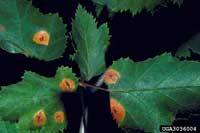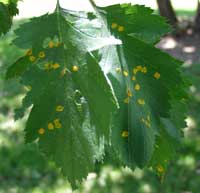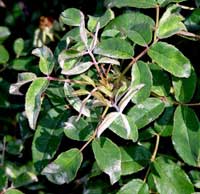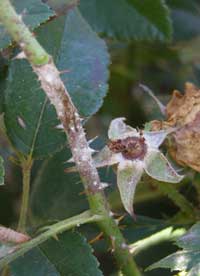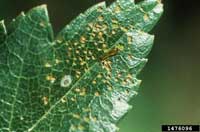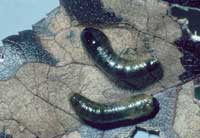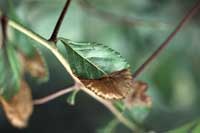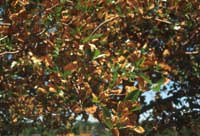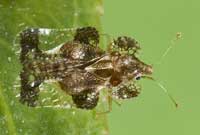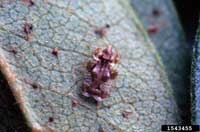Extension > Garden > Diagnose a problem > What's wrong with my plant? > Deciduous > Hawthorn > Dots, spots or blotches on leaves
Hawthorn > Leaves > Dots, spots or blotches on leaves
1 of 5
Cedar-hawthorn rust
Gymnosporangium globosum
- Yellow to orange spots on leaves
- Leaves may turn bright yellow and drop
- White, tubular fungal spore producing structures up to ½ inch long form on lower surface of leaf spots
- Can infect and deform fruit and green stems
- More information on Cedar-hawthorn rust
2 of 5
Powdery mildew
Podosphaera spp. and Phyllactinia guttata
- White-grey, felt-like spots or patches on leaves
- Infected leaves may curl, twist or fold upwards
- Infected blossoms are distorted, discolored and covered in white powdery fungal growth
- Lower shaded leaves and small, understory trees are most commonly affected
- More information on Powdery mildew
3 of 5
Pear sawfly
Caliroa cerasi
- Larvae "windowpane" feed i.e. eat upper leaf surface but leave veins
- Heavy feeding gives tree a scorched appearance
- Premature leaf drop
- Larvae are about ½ inch long, shiny, slug-like, initially dark green to black
- More information on Pear sawfly
4 of 5
Hawthorn leafminer
Profenusa canadensis
- Larvae feed between leaf surfaces causing translucent spots or blotches on leaves primarily on the leaf tips
- Injured areas turn brown; from a distance, foliage appears scorched
- Frass (droppings) noticeable, especially when leaf held up to a light
- More information on Hawthorn leafminer
5 of 5
Hawthorn lace bug
Corythucha cydoniae
- Pinprick whitish to yellow-brown discoloration on upper surface
- Persistent feeding can cause damaged areas to coalesce into blotches
- Black dots or specks (droppings) on underside of leaves
- Heavy feeding can cause leaf drop
- Damage is most notable mid to late summer
- Adults are about 1/8" long, light brown bodies with intricate, lacy wings
- More information on Hawthorn lacebug



